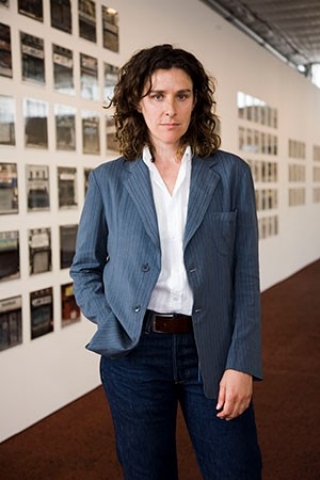Born 1961, Liberty, New York
Zoe Leonard, who never formally studied photography, first rose to prominence after her participation in Documenta 9 in Kassel, Germany, in 1992, where she hung black-and-white photographs of female genitalia among the traditional paintings installed at the Neue Galerie. She has since become known for her varied explorations of the utilitarian and quotidian horizons of photography. Between 1998 and 2007 she produced Analogue, an archive of photographs that records the aesthetics of urban storefronts and the global circulation of commerce. The project drew on the documentary approach of photographers from Eugène Atget to Bernd and Hilla Becher while foregrounding the burgeoning obsolescence of photographic tools (she used a vintage Rolleiflex camera) and time-honored printing processes. Leonard has also surveyed the vernacular form of souvenir postcards and the prephotographic technology of the camera obscura.
In 1993 the filmmaker Cheryl Dunye approached Leonard about producing a fictional trove of images for her forthcoming feature-length film, The Watermelon Woman (1996). The protagonist in the film searches for a connection to Fae Richards, a fictional black lesbian actress from the early twentieth century known as “the Watermelon Woman,” and finds photographs of Richards at the “CLIT Archives.” Unable to source archival material to serve as a suitable reference, Dunye worked with Leonard to stage the images, which appear briefly as props in the film. Leonard and Dunye also published these photographs as a photo album in 1996, and Leonard’s eighty-two prints were included in the 1997 Whitney Biennial as The Fae Richards Photo Archive.
Photographing several women in the role of Richards, Leonard manufactured an elaborate archive, as notable for the diversity of photographic idioms it includes as for the gaps and elisions that interrupt it. The images range from slick, glamorous headshots and film stills to more intimate snapshots. A multifaceted sense of the fictional actress’s life emerges from the ensemble, sensitive to the social constraints and discrimination Richards would have experienced as well as to her accomplishments and everyday joys and sorrows. Period-specific costumes, a variety of photographic processes, and faux aging treatments all contribute to the realism of the project without obscuring its constructed origins.
Jenevive Nykolak
Leonard, Zoe, and Cheryl Dunye. The Fae Richards Photo Archive. San Francisco: Artspace Books, 1996.
